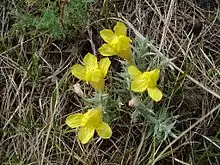| Cymbaria | |
|---|---|
 | |
| Cymbaria daurica | |
| Scientific classification | |
| Kingdom: | Plantae |
| Clade: | Tracheophytes |
| Clade: | Angiosperms |
| Clade: | Eudicots |
| Clade: | Asterids |
| Order: | Lamiales |
| Family: | Orobanchaceae |
| Tribe: | Cymbarieae |
| Genus: | Cymbaria L.[1] |
| Species | |
|
See text | |
| Synonyms[2] | |
| |
Cymbaria is a genus of flowering plants in the broomrape family Orobanchaceae, native to Ukraine, Russia, Kazakhstan, Siberia, the Altai, Mongolia, northern China and Manchuria.[2] They are hemiparasites of other plants, obtaining nutrients through haustoria which attach to the roots of the hosts, and doing some photosynthesis on their own.[3]
Species
The following species are recognised in the genus Cymbaria:[2]
- Cymbaria borysthenica Pall. ex Schltdl.
- Cymbaria chaneti Gand.
- Cymbaria daurica L.
- Cymbaria mongolica Maxim.
References
- ↑ Sp. Pl.: 618 (1753)
- 1 2 3 "Cymbaria L." Plants of the World Online. Board of Trustees of the Royal Botanic Gardens, Kew. 2023. Retrieved 19 November 2023.
- ↑ Bennett, Jonathan R.; Mathews, Sarah (2006). "Phylogeny of the parasitic plant family Orobanchaceae inferred from phytochrome A". American Journal of Botany. 93 (7): 1039–1051. doi:10.3732/ajb.93.7.1039. PMID 21642169.
This article is issued from Wikipedia. The text is licensed under Creative Commons - Attribution - Sharealike. Additional terms may apply for the media files.